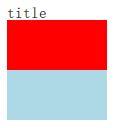Qml存在一个神秘附加属性(default)却是很少用,少用却是很好用。看看我这是怎么用的吧。
1.default附加属性
- 组件内部(
{}内)仅此一个default标记。 - 被deault标记的属性可以使用外部对象。
2.示例1
MyText.qml组件内部引用外部对象的两种方法。1
2
3
4
5
6import QtQuick 2.0
Text {
default property variant textObject
text: textObject.text
}
方法一:
- textObject值可以在MyText对象定义中赋值。
MyText的Text控件被引用到textObject中使用。1
2
3MyText {
Text { text: "xxxxx" } // 默认传递给textObject值。
}
方法二:
- 上面操作等同于:
1
2
3MyLabel {
textObject: Text { text: "xxxxx" } // 等同于默认传递给textObject值。
}
3.例子2
看似很没用的属性却说有用,还说好用。第一个例子看起来和常规做法差不多。那么我们看看第二个例子使用起来是如何好用的。
Group.qml组件:1
2
3
4
5
6
7
8
9
10
11
12
13import QtQuick 2.0
FocusScope {
property alias title: title.text
default property alias items: colume.children
Text { id: title }
Column {
id: colume
anchors.top: title.bottom
}
}
Group的使用:
1 | Group { |
如果不使用该特性则需要这样做:
如需要多个地方使用则需要重复操作,管理不方便,且理解不直观。1
2
3
4
5
6
7
8
9
10
11
12
13
14
15
16
17Column {
Text {
text: "title"
}
Column {
Rectangle {
width: 100; height: 50;
color: "red"
}
Rectangle {
width: 100; height: 50;
color: "lightblue"
}
}
}
效果:
4.最后
从上面例子可以看到Group组件具备Column控件的布局功能,并扩展出类似于Group Box控件的功能。原因在于colume.children引用了Group的子控件触发自动布局。
对于上面例子我们还可以内部操控items对象列表来操作Group上的子控件属性,如item[0].visible = false来隐藏红色矩形控件。
这样做我们就可以增强组件的功能,降低代码量,特别是那些具备标题栏或某些附属栏的组合框。
- 文章首发于微信公众号:Qt君